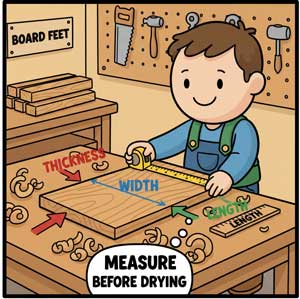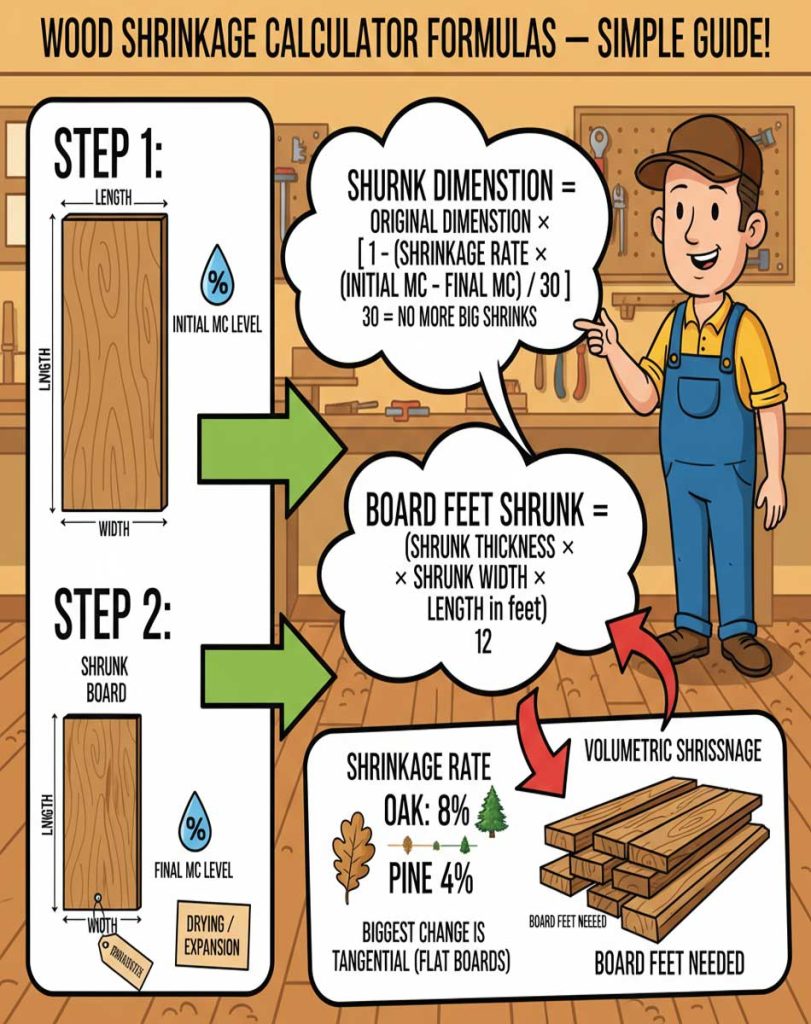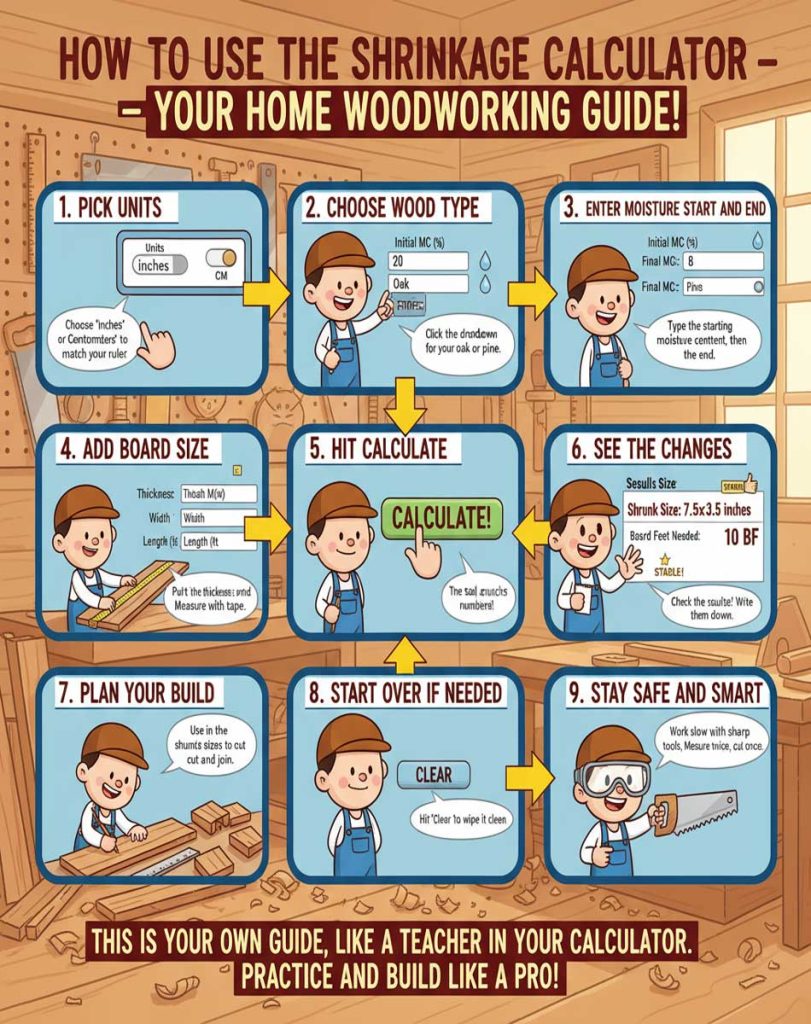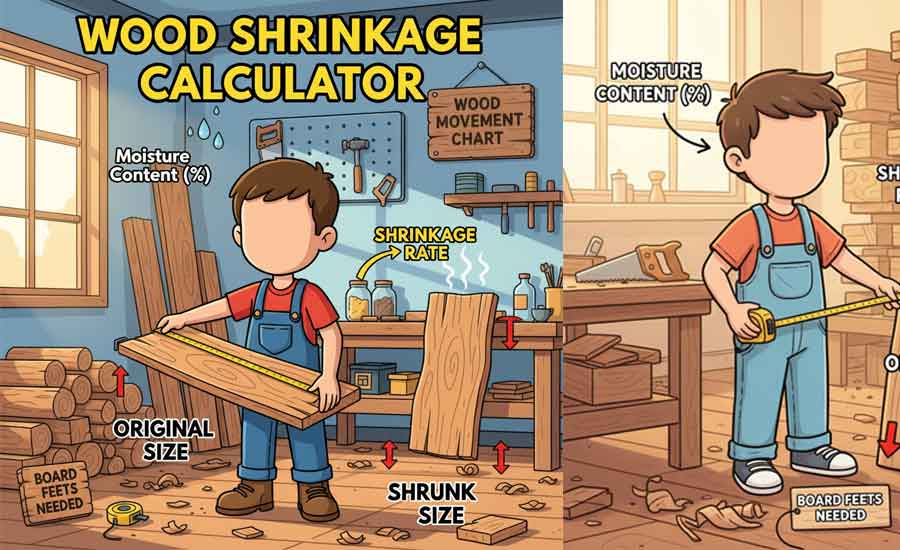Hey woodworker, remember that time I built a shelf and the wood twisted a bit as it dried? It happens to everyone starting out. Wood is alive in its own way - it shrinks when it loses water from the air.
This wood shrinkage calculator, or lumber shrinkage calculator as some call it, is like a secret map to predict that. It helps you figure how your boards will change size as they dry. No more surprises in your projects like a wobbly table.
It's great for hardwood shrinkage or softwood shrinkage, whether it's tangential shrinkage across the grain or radial shrinkage with the grain.
You pick the wood type, how wet it starts, how dry it ends, and the size. Boom - it tells you the new size and even the wood movement in board feet. Think of it as planning for your wood's mood swings!
Wood Shrinkage Calculator

The Formula This Calculator Uses

This tool uses a tried-and-true rule from years in the shop: Shrunk Dimension = Original Dimension × [1 - (Shrinkage Rate × (Initial MC - Final MC) / 30)]
- Shrinkage Rate is the wood's special number for how much it shrinks (like 8% for oak across the grain).
- MC is moisture content, the water level in the wood.
- 30 is the point where wood stops shrinking big time.
For board feet, it does: Board Feet Shrunk = (Shrunk Thickness × Shrunk Width × Length in feet) / 12.
This comes from watching wood dry over decades. It covers wood drying calculator needs, wood expansion calculator too if MC goes up, and even volumetric shrinkage for the whole piece. Always use tangential for flat boards—it's the biggest change.
How to Use the Calculator – Your Home Woodworking Guide!
Hey there, young woodworker! This calculator is your very own helper at home, like a friendly teacher right by your side. It’s super easy to use, and I’ll guide you step by step so you can measure and plan wood changes all on your own. Let’s get started and avoid those sneaky shrinks—safely and with lots of fun!
- Pick Units Look at the "Units" box. Choose "Inches" or "Centimeters" to match your ruler. This keeps numbers right for you.
- Choose Wood Type Click the dropdown for your wood, like oak or pine. Each has its own shrink rate from the wood movement chart. Pick what you're using.
- Enter Moisture Start and End Type the starting moisture content, like 20% if it's fresh from the mill. Then the end, like 8% for dry indoors. This shows how much water leaves.
- Add Board Size Put in the thickness and width in your units. Length too if you want board feet. Measure the rough board with a tape—hold it flat.
- Hit Calculate Press the "Calculate" button. The tool crunches the numbers fast, like magic.
- See the Changes Check the results! It shows new sizes after shrink. Board feet needed. Even a note if it's stable. Write them down.
- Plan Your Build Use the shrunk sizes to cut and join. Add a bit extra space for joints. Test a scrap first.
- Start Over if Needed Hit "Clear" to wipe it clean. Try different wood or moisture for what-if fun.
- Stay Safe and Smart Work slow with sharp tools. Ask an adult nearby. Measure twice, cut once. You're the boss now!

This is your own guide, like a teacher in your calculator. Practice these steps, and soon you'll tame wood movement like a pro—all by yourself!
Questions & Answers on Wood Shrinkage
What is the formula for wood shrinkage?
Answer: Shrinkage (%) = ((Original Dimension – Final Dimension) ÷ Original Dimension) × 100.
or
Shrinkage % = (Initial size − Final size) / Initial size × 100
👉 In simple words, you measure how much the wood size changed, divide by the starting size, then multiply by 100. Example: If a board was 100 cm wide and shrinks to 98 cm, that’s (100–98)/100 × 100 = 2% shrinkage.
Bonus (to predict change): Size change ≈ Original width × movement rate × moisture change (below ~30% MC).
How much does wood shrink and expand?
Answer: Most wood shrinks or swells about 2–8% across the grain, depending on species and moisture change. Along the grain, shrinkage is very small (less than 1%).
Across the width, about 2% to 10% from green to oven-dry, depending on species and direction. Length change is tiny.
Details: Width moves most. Oak can be 7–10% across the rings. Pine is lower, near 3–5%. Along the length, change is usually under 0.3%.
Everyday check: See gaps in wood floors in winter? That’s this.
👉 Think of a cutting board: it doesn’t really get shorter, but it might bow or get tighter/looser in width depending on the season.
Does wood shrink when moisture content is reduced from 60% to 30%?
Answer: Yes. Wood shrinks as it loses moisture above its fiber saturation point (around 28–30%). Dropping from 60% to 30% means a big moisture loss, so the wood will definitely shrink. But it won't call wood shrink. It's called free water loss. Real shrinkage starts below about 30% MC (fiber saturation point).
Details in Short: From 60% to ~30%, wood is losing “free water.” Size barely changes. Below ~30%, it loses “bound water.” That’s when it shrinks.
What is the shrinkage rate of wood?
Answer: On average, radial shrinkage is about 3–5%, tangential shrinkage 6–10%, and longitudinal shrinkage less than 1%.
Below ~30% MC, expect roughly:
Along the length: ~0.01–0.03% per 1% MC (tiny)
👉 Translation: across the rings (tangential) is where wood moves the most. That’s why boards can cup or warp.
Across the rings (tangential): ~0.25–0.30% width change per 1% MC change
Through the rings (radial): ~0.12–0.20% per 1% MC
Details: Rates vary by species. Oak moves more than maple; maple moves more than cedar.
Does wood shrink when it’s cold?
Answer: Not directly. Wood doesn’t care about temperature itself - it cares about humidity. Cold air usually holds less moisture, so wood in a cold, dry room can shrink.
Details: Winter air inside homes is dry. Wood loses moisture and shrinks. In a sealed bag in a freezer, it won’t change size.
Does wood shrink when it’s hot?
Answer: Again, it’s not the heat but the dryness. Hot, dry air pulls out moisture, so wood shrinks. Hot, humid air does the opposite — wood swells.
Details: Heat speeds up drying. Drying causes shrinkage. Heat alone, without moisture loss, does not.
Which type of wood shrinkage is greatest?
Answer: Tangential shrinkage (around the growth rings) is greatest. That’s why flat-sawn boards move more than quarter-sawn ones.
Details: Radial (through the rings) is about half of tangential. Lengthwise is the least.
What is an acceptable moisture reading?
Answer: For indoor furniture, 6–8% is good. For construction lumber, 8–14% depending on climate.
- Indoor furniture: 6–8%
- Indoor flooring: 6–9% (match the house)
- Exterior projects: 12–18% (varies with climate)
- Framing lumber: 19% or less at delivery is common
Details: Aim for the wood to match the room where it will live.
👉 Example: If you’re in a humid place like Bangladesh, slightly higher readings are normal compared to a desert climate.
What is the best moisture meter for wood?
Answer: Pin-type meters are most accurate because they measure resistance inside the wood. Wagner and Delmhorst are trusted brands among professionals.
- Most accurate on average: Pin-type (they read inside the wood fibers)
- Best pro pinless: Wagner Orion series (fast, no pin holes)
- Solid pin-type pick: Delmhorst J‑2000 (reliable, species settings)
- Great value: Lignomat Mini‑Ligno (simple, dependable)
Details: Pin meters leave tiny holes but are very direct. Pinless meters are quick and clean; keep the face flat on the board and set the species correctly.
How long does it take for wood to shrink?
Answer: It depends on thickness, airflow, and humidity. A 1-inch thick board can take several weeks to months to reach equilibrium indoors. Thin boards in a warm shop can change in weeks. Thick boards can take months.
Details: Rule of thumb for air-drying rough lumber: about 1 year per inch of thickness to reach ~12% MC. Then a few weeks indoors to reach 6–9%. Kiln drying is much faster.
Is 5% shrinkage a lot?
Answer: Yes, 5% across the grain is noticeable. A 12-inch wide board could lose over half an inch. That’s enough to cause warping or joints to open.
Details: A 10-inch (254 mm) board losing 5% in width drops about 0.5 in (13 mm). That’s a big gap on a tabletop.
How to calculate percent shrinkage?
Answer: Formula: (Change in Dimension ÷ Original Dimension) × 100.
👉 Example: A 200 mm wide plank shrinks to 194 mm. That’s (200–194)/200 × 100 = 3% shrinkage.
- Tip (to predict with moisture): Width change ≈ Width × movement rate × MC change (below ~30% MC). Example: 10 in board, tangential rate 0.25%/1% MC, drop of 4% MC → 10 × 0.0025 × 4 ≈ 0.10 in.
A quick story: I once rushed a maple tabletop into glue-up before it settled in the house. Looked perfect that day. By winter, a seam opened about a sixteenth. My fault. I hadn’t let it reach the room’s moisture level. Now I sticker boards and give them time. Saves headaches.
Everyday picture: If your front door sticks in summer and swings easy in winter, that’s wood movement. Same thing happens to cutting boards, shelves, and floors.
👉 Bottom line: wood will always move. You can’t stop it, but you can plan for it. Pick the right wood, use the right joinery, and know the numbers — and you’ll save yourself a lot of frustration later.

